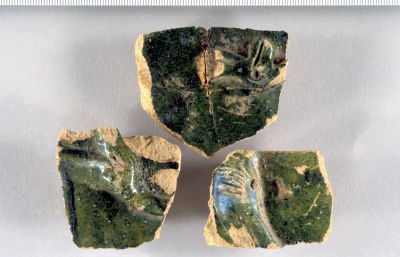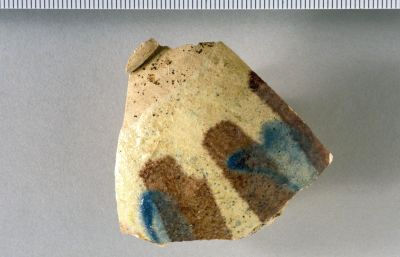
In this report, common names for the various classes of imports have been used. Comparison may still be made with earlier reports (Cameron and Stones 2001, 159) as a common name appears there with the fabric series number. Where no common name exists, a vessel has simply been listed here as 'non-local glazed', or 'non-local unglazed'.
In the 12th and early 13th centuries, white gritty wares (previously called East Coast Scottish Gritty wares, Murray 1982, 119, fabrics 12-16) were imported from production sites in southern Scotland. This type of ware probably continued in production until the 15th century (Hall 2003, 89) but the quantity found in 14th and 15th century contexts in Aberdeen is significantly reduced from the large percentage found in 12th and 13th century layers. Many of the sherds found at this site are residual and reflect pre-Carmelite activity in the area.
The various Yorkshire-type wares (Murray 1982, 120, fabrics 18-20, previously called Scarborough and Scarborough-type wares) constitute the only major medieval ceramic imports, making up 30% of the assemblage in some sites in Aberdeen. The majority of sherds come from jugs [822] including examples with three-dimensional decoration such as knight jugs with fragments of shields [804, 760] and the eye and ear of a horse [2080]. Two fragments of decorated jugs include a spout decorated with a beast's head [2050] (Figure 16) and a possible hunting scene [2051] [Photo 0282]. There are also jars [752] and a possible chafing dish [808].

The evidence from excavations in Aberdeen suggests that Yorkshire-type wares were imported in considerable numbers into Aberdeen throughout the 13th and 14th centuries. The degree of completeness of a number of pieces found previously in Aberdeen shows that some Yorkshire-type vessels were still in use in the closing years of the 14th century. There is no indication that any trade in pottery with this part of northern England persisted after c.1400.
Medieval pottery from other English production centres (Fabrics 21-27: Murray 1982, 120) represents a negligible portion of the total assemblage.
Of the medieval continental imports, the most significant are those from the Low Countries (Murray 1982, Fabrics 32-37, 121). This merely confirms both the known historical links with this area (Murray 1982, 16; Ditchburn 1988, 164, 168, 170), and the trends set by earlier excavations in the burgh (Murray 1982, 124-5; Murray 1984, MF 3:E10 and Table 1; Verhaeghe 1983, 11-16). However, as Verhaeghe has stressed, pottery clearly represented only a minor element of a far more important trade in other commodities, and his overall conclusion is reinforced by the evidence from these sites, where Low Countries wares constitute a small percentage of the total ceramic assemblage.
Low Countries Highly Decorated wares (previously called Aardenburg type ware, Murray 1982, 121, fabric 32) are represented by jug sherds [844].
Greywares from the Low Countries were imported into Scotland from the mid to late 12th century and were gradually replaced by redwares in the mid 14th century. Greywares are more common in Aberdeen in contexts dating to the late 13th and 14th centuries. They are represented mainly by jugs [787] and jars [20071].
Dutch redwares were found in small numbers at this site. Redwares were produced in all the same vessel types as the greywares, but the main vessel types identified from Aberdeen sites were cooking pots, bowls or flat platters (Figure 16) and skillets [750]. In the Low Countries, redwares started to be produced in the 13th century, but became more prominent from c.1300 and by c.1350 they were seriously competing with the greywares; through the 15th century they become more prominent (Verhaeghe 1983, 27).
French wares
A very small number of sherds of French imports were found on this site including a sherd of Saintonge polychrome [788] (Figure 16), the remains of a possible holy water stoup (Hurst et al. 1986, 85) [Photo 0274]. A small number of Beauvais products are present including a fragment from a dish [858] found in a Phase 6 mortar floor, dating from the late 15th or 16th century.

German wares
A small number of German earthenwares were imported into Scotland during the 12th and 13th centuries. Paffrath-type products are mainly represented by fragments of blue-grey ladles [784, 829]. Some of the sherds identified as Fabric 33 (Aardenburg-type ware and now known as Low Countries Highly Decorated Ware; Murray 1982, 121) may in fact have a north German origin (Verhaeghe 1983, 11).
Spanish wares
A small number of sherds of vessels from Valencia and Andalusia have been found on sites in Aberdeen previously (Cameron and Stones 2001, cat nos 25, 70). One sherd of a dish from this site [809] was decorated with light and dark turquoise and trails of brown slip on a smooth pinkish orange fabric, thought to be of Spanish origin.
Aberdeen excavations produce consistent amounts of medieval and early post-medieval stonewares. The exact place of manufacture of many small sherds of stoneware is often difficult to determine, and therefore in this report most of the stonewares are called, for example, Langerwehe-type and Cologne/Frechen-type. Siegburg-type stonewares date mainly to the late 14th and 15th century and are represented mainly by sherds of tall slender jugs or Jacobakannen [766], but a bowl [798] and costrel [800] are also present. Langerwehe-type vessels, dating to the 14th and 15th century, were mainly represented by jugs [810] [764] (Figure 16).
A Cologne /Frechen-type jug [765] is probably of mid 16th century date (Hurst et al. 1986, 211-3) and may represent activity just prior to the Reformation. A tankard base from Westerwald [777] (Figure 16) is probably of late 16th- or early 17th- century date (Gaimster 1997, 257) and therefore may represent post-Carmelite activity.
Internet Archaeology is an open access journal based in the Department of Archaeology, University of York. Except where otherwise noted, content from this work may be used under the terms of the Creative Commons Attribution 3.0 (CC BY) Unported licence, which permits unrestricted use, distribution, and reproduction in any medium, provided that attribution to the author(s), the title of the work, the Internet Archaeology journal and the relevant URL/DOI are given.
Terms and Conditions | Legal Statements | Privacy Policy | Cookies Policy | Citing Internet Archaeology
Internet Archaeology content is preserved for the long term with the Archaeology Data Service. Help sustain and support open access publication by donating to our Open Access Archaeology Fund.